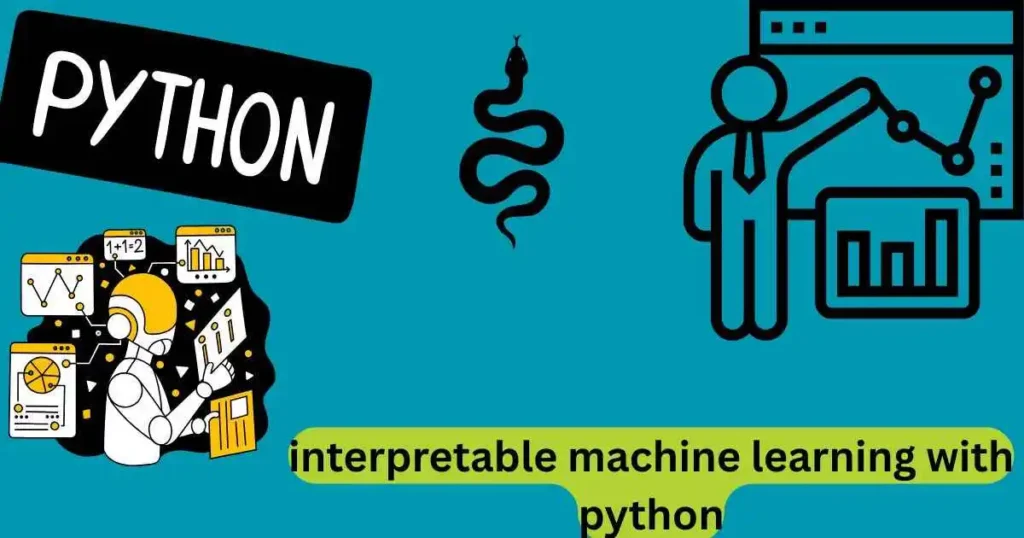There are numerous uses for machine learning models in the fields of data science and artificial intelligence (AI) nowadays. Machine learning is revolutionizing a variety of areas, from financial forecasting to healthcare predictions. Nevertheless, most of these models are “black boxes”; they function effectively, but it’s challenging to comprehend how they arrive at their results. This lack of openness can be troublesome, particularly in crucial fields like healthcare or finance, where judgments must be supported by evidence.
This is where Interpretable Machine Learning with Python is useful. You can make well-informed judgments based on comprehensible insights by improving the interpretability of models. The foundations of interpretable machine learning, Python tools, and the significance of making black-box models explicable will all be covered in this essay.
Interpretable Machine Learning with Python: What Is It?
The process of making machine learning models more transparent and intelligible to humans is known as Interpretable Machine Learning with Python. Interpretable models explain of how and why they reached their conclusions rather than just presenting the data. This is particularly important for fields where decisions can affect lives and livelihoods, such as healthcare, banking, and law.
The ultimate objective is to transform “black-box” models—such as deep learning models—that are challenging for people to understand into something that non-experts can grasp with ease. We can maintain justice, build trust, and adhere to rules by doing this.
Python-Based Interpretable Machine Learning with Python:
The Potential of Python Libraries Python is among the best languages to utilize for interpretable machine learning. Python’s vast library ecosystem facilitates the development, training, and explanation of machine learning models.
Let’s examine a few well-liked Python tools for improving the interpretability of models.
- The Interpretation Library Interpretml is one of the most potent Python packages for interpretable machine learning. It offers a collection of interpretability-focused machine learning models and tools. Popular models for creating interpretable models, such as ExplainableBoostingRegressor and ExplainableBoostingClassifier, are supported by the library.
A machine learning model for regression tasks is called ExplainableBoostingRegressor. It makes it simpler to comprehend how features affect the model’s output by providing concise justifications for predictions.
ExplainableBoostingClassifier: Classification difficulties are addressed by this model. It is a useful tool for tasks like fraud detection or client segmentation since it offers insight into how factors affect the anticipated class.
Compared to conventional black-box models, these models are more transparent and have a greater range of applications.
Transparency in Neural Networks via Interpretable Deep Learning Most people associate machine learning with deep learning models, which are neural networks that can play games, translate languages, and recognize images. Despite its immense capability, deep learning is frequently perceived as a mystery. The goal of interpretable deep learning is to improve the comprehension of neural networks.
Methods for Deep Learning That Are Interpretable There are several methods for improving the interpretability of deep learning models, including:
A neural network’s decision-making process can be seen with the aid of Layer-wise Relevance Propagation (LRP).
Saliency maps show which elements of an input—such as a word or image—are most crucial to a model’s ability to forecast.
By giving each characteristic a “Shapley value,” which denotes its contribution to the model’s choice, SHAP (SHapley Additive reasons) offers reasons for individual forecasts.
These techniques make it simpler for practitioners to trust and enhance deep learning models by providing insight into the reasons behind certain predictions.
Why Interpretable AI Is Important The term “interpretable AI” describes the larger category of AI methods that emphasize openness and comprehension. Interpretability is essential since AI is being used in vital fields, including healthcare, finance, and law enforcement.
We can guarantee their ethical and responsible use by creating interpretable AI models. We can identify biases, validate judgments, and make sure AI systems are making just and fair decisions thanks to interpretable models.
A Comprehensive Guide to Developing an Interpretable Python Machine Learning Model After discussing the significance of interpretable machine learning, let’s see how to create one using Python. This is a detailed tutorial that makes use of the interpretml library.
First, install the library. Installing the interpretml library is the first step. Pip can be used for this:
Copy, edit, install, and interpret with bash Step 2: Bring in the Required Libraries Then, import the required libraries, such as scikit-learn (a well-known Python machine learning package) and interpretml:
Python Copy and edit import train_test_split from sklearn.ensemble import import pandas as pd from sklearn.model_selection import from interpret import interpret from interpret.blackbox import RandomForestClassifier Explainable Boosting Classifier Step 3: Get Your Information Ready We’ll utilize a straightforward dataset for this example. Any dataset that addresses your issue can be used, such customer churn or the Iris dataset.
Python A copy pd.read_csv(‘your_dataset.csv’) Edit data X = data.drop(axis=1, ‘target_column’) [‘target_column’] = data[y]
Train_test_split(X, y, test_size=0.2, random_state=42) = X_train, X_test, y_train, y_test Step Four: Develop an Explainable Model An interpretable machine learning model will be trained using the ExplainableBoostingClassifier:
Python Model = ExplainableBoostingClassifier() model is copied and edited.X_train, y_train fit Step 5: Examine the Model After the model has been trained, its predictions can be explained using the interpret library:
Python A copy Modify explanation to read interpret(model). explainer.explain_local(X_test) explanation = explanation.display_in_notebook() Step Six: Assess the Model Finally, use common assessment measures to assess the model’s performance:
Python Duplicate Model.score(X_test, y_test) = edit accuracy “Accuracy: {accuracy:.2f}” print(f) Python-Based Interpretable Machine Learning GitHub You can look at the interpretable machine learning using the Python GitHub repository for further resources, examples, and code snippets. This includes a plethora of materials to help you get started with interpretable machine learning, including as tutorials and sample notebooks.
Conclusion: Use Python to Adopt Interpretable Machine Learning To sum up, interpretable machine learning with Python is a potent technique to improve the transparency and understandability of your machine learning models. You can create models that are both interpretable and perform well by utilizing libraries such as interpretml, ExplainableBoostingRegressor, and ExplainableBoostingClassifier.
Adopting interpretability is essential to creating reliable AI systems, regardless of whether you’re working with deep learning or conventional machine learning models. Making your models interpretable will help you stay ahead of the curve as the need for ethical AI grows.
If you’re using the CSU Machine Learning Server, learning interpretable machine learning with Python can help you better understand your model’s behavior and make smarter, more confident decisions with your data.


